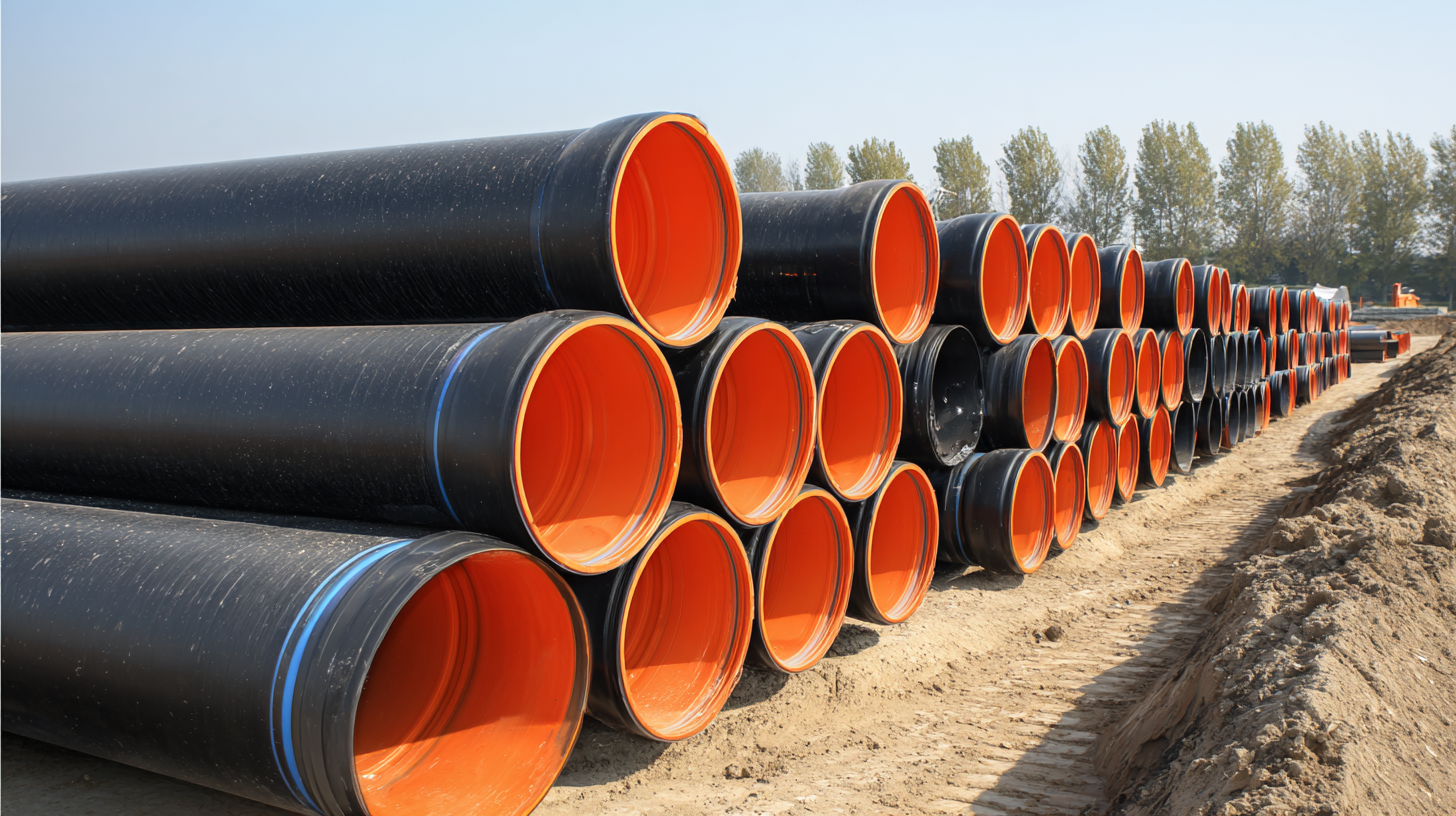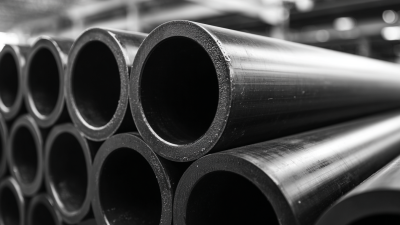-
Products and Systems
Products and Systems
Vinidex manufacturers and supplies a broad range of products & systems to suit a range of applications.
-
Solutions
Solutions
Vinidex’s products and systems are versatile and can be used in a variety of markets and applications.
- Resources
-
Understanding the Benefits and Applications of HDPE Plastic Pipe in Modern Infrastructure
In modern infrastructure, the use of HDPE plastic pipe has gained significant traction due to its numerous advantages over traditional materials. According to a report by MarketsandMarkets, the global HDPE pipe market is projected to reach USD 21.8 billion by 2025, reflecting a compound annual growth rate (CAGR) of 4.5%. This growth is attributed to the material's exceptional resistance to corrosion, its ability to withstand high pressures, and its long service life, which can exceed 50 years.

Furthermore, HDPE plastic pipe is lightweight and flexible, facilitating easier installation and reducing transportation costs. These benefits make HDPE an ideal choice for various applications, including water supply, wastewater management, and industrial systems. As municipalities and industries increasingly prioritize sustainable and efficient infrastructure solutions, understanding the role and applications of HDPE plastic pipe becomes essential for stakeholders looking to enhance their projects' longevity and performance.
Benefits of HDPE Plastic Pipe in Water Distribution Systems
The increasing adoption of HDPE plastic pipes in water distribution systems is transforming modern infrastructure. According to market projections, the HDPE pipes market is expected to reach USD 25.68 billion by 2029, highlighting the growing need for sustainable and durable solutions in water management. The advantages of HDPE pipes are numerous; they are not only resistant to corrosion and chemical exposure, but also offer flexibility and ease of installation. This makes them ideal for various applications in municipal water supply, where reliability and efficiency are paramount.
The Southern African Plastic Pipe Manufacturers Association (SAPPMA) recently reported significant growth in demand for large diameter HDPE pipes, indicating that municipalities and contractors are increasingly recognizing their benefits. This trend is further supported by the rise in infrastructure investments and advancements in polymer technology, which enhance the performance of HDPE pipes. With the ongoing PR campaign "Truth About Pipes," stakeholders are urged to make informed decisions about plastic pipe usage based on factual data, reinforcing the critical role HDPE pipes play in ensuring safe and efficient water distribution systems.

Key Applications of HDPE in Wastewater Management
HDPE (High-Density Polyethylene) plastic pipes have emerged as a pivotal solution in wastewater management, owing to their robust properties and versatility.
These pipes are resistant to corrosion, chemical deterioration, and UV exposure, making them ideal for conveying wastewater in municipal and industrial applications.
Their flexibility allows for easier installation in various terrains, reducing the need for extensive excavation and lowering overall project costs. As urban environments continue to evolve, the demand for efficient and reliable wastewater systems emphasizes the importance of HDPE pipes in modern infrastructure.
The projected growth of the HDPE pipes market, reaching USD 25.68 billion by 2029, reflects a significant shift towards sustainable and resilient infrastructure solutions.
This growth trajectory is propelled by the increasing need for effective wastewater management systems that can adapt to changing environmental conditions.
As cities adopt decentralized water systems to enhance resource efficiency, HDPE pipes play a crucial role in supporting these initiatives, ensuring that communities can manage wastewater sustainably and effectively.
The ongoing innovation in HDPE technology further reinforces its position as a key player in the future of urban infrastructure development.
Cost-Effectiveness of HDPE Pipes in Infrastructure Projects
HDPE (High-Density Polyethylene) pipes have emerged as a cost-effective solution for various infrastructure projects, showcasing significant financial advantages over traditional materials. According to a study conducted by the American Water Works Association, HDPE pipes can reduce total installation costs by up to 30% compared to conventional methods. This cost-effectiveness is attributed to their lightweight nature, which requires less labor and equipment for installation, as well as their resistance to corrosion and chemicals, leading to lower maintenance expenses over the long term.
In addition to lower upfront and ongoing costs, HDPE pipes also contribute to overall project savings through their durability and longevity. Industry reports indicate that these pipes have a lifespan exceeding 50 years with minimal degradation. The National Association of Sewer Service Companies emphasizes that the reduced need for repairs and replacements translates into significant savings for municipalities and project developers. These financial benefits are particularly crucial in today's economic climate, where budget constraints often challenge infrastructure development efforts. By investing in HDPE technology, stakeholders can not only enhance infrastructure reliability but also ensure their projects remain within budget.
Understanding the Benefits and Applications of HDPE Plastic Pipe in Modern Infrastructure - Cost-Effectiveness of HDPE Pipes in Infrastructure Projects
| Dimension | Value | Comments |
|---|---|---|
| Typical Pipe Lifespan | 50-100 years | Long-lasting material reduces replacement costs. |
| Cost per Foot | $1.50 - $3.00 | Comparatively lower than traditional materials. |
| Weight | Lightweight | Ease of handling and installation. |
| Resistance to Corrosion | High | Increases durability in various environments. |
| Flexibility | Moderate | Suitable for various installation methods including trenchless. |
| Environmental Impact | Recyclable | Supports sustainability initiatives. |
| Applications | Water distribution, sewage systems, gas distribution | Versatile use across multiple sectors. |
Sustainability and Environmental Impact of HDPE Materials
HDPE (High-Density Polyethylene) plastic pipes have become a vital component in modern infrastructure, primarily due to their sustainability and lower environmental impact. According to the Plastics Industry Association, HDPE is fully recyclable, allowing for the reuse of materials and reducing landfill waste. This attribute is essential in today's eco-conscious society, where approximately 30% of plastic waste is recycled, as reported by the European Commission. The durability and long lifespan of HDPE pipes—typically exceeding 50 years—further contribute to their appeal, diminishing the frequency of replacement and thus minimizing the ongoing environmental burden associated with traditional materials.

In terms of applications, HDPE's resistance to corrosion and chemicals makes it suitable for various infrastructure projects, from water supply to wastewater treatment. The National Association of Counties highlights that replacing conventional materials with HDPE can result in a reduction of carbon emissions by up to 50% during transportation and installation.
Tips: When choosing materials for infrastructure projects, consider HDPE for both its performance and environmental benefits. Additionally, collaborating with suppliers who emphasize sustainable practices can amplify these advantages. Always ensure to verify the recyclability of materials used in your projects to align with best environmental practices.
Installation Techniques and Best Practices for HDPE Pipes
HDPE pipes, known for their exceptional durability and resistance to corrosion, have become increasingly popular in modern infrastructure projects. When it comes to installation, a few techniques can significantly enhance performance and longevity. According to the Plastics Pipe Institute, HDPE pipes can last over 100 years when correctly installed, making it crucial to follow best practices during the installation process. Proper fusion welding is essential, as this method ensures a continuous and leak-free joint that maintains the integrity of the pipeline. Additionally, using the right equipment and adhering to temperature guidelines can further enhance the reliability of the connections.
Another vital aspect of HDPE pipe installation is the trench preparation and backfilling procedures. The American Society for Testing and Materials (ASTM) recommends that trenches be dug to a minimum depth that allows for adequate protection around the pipe. This is particularly important in preventing structural damage from external loads. Moreover, the need for careful backfilling with non-cohesive materials helps minimize the risk of settling and provides stable support for the pipeline. Following these best practices ensures that HDPE pipes serve their intended purpose in transporting fluids efficiently and safely across extensive infrastructures.
Related Posts
-

Understanding the Essential Role of PE Pipe Fittings in Modern Plumbing Systems
-

Exploring the Versatility of Black Plastic Pipe in Modern Infrastructure Solutions
-

Understanding the Role of Polyethylene Pipe in Sustainable Water Management Practices
-

The Ultimate Guide to PVC Pipes and Fittings: Exploring Benefits, Standards, and Market Trends
